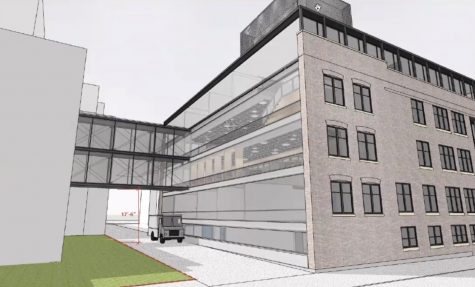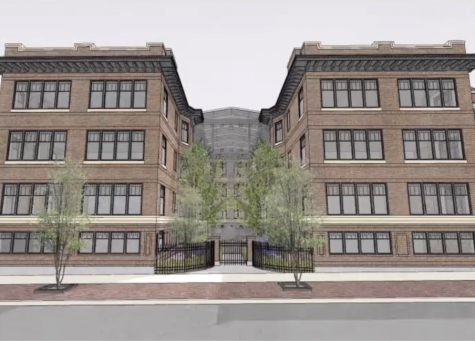The Belden buildings, 317-325 West Belden Avenue.
Buildin’ on Belden
Parker Purchases 317-325 W Belden Building Following Controversy
Parker is due to expand their Model Home both beyond its current acreage and student body size after their purchase of the apartment buildings at 317-325 West Belden Avenue. On Wednesday, September 16, Alderwoman Michelle Smith hosted a community meeting and Q and A over Zoom with Principal Dan Frank about the project, following the announcement of the sale on September 10.
Also representing the school was Parker Board member and architect Chip Von Weise and Parker Attorney Langdon Neal, who specializes in real estate, zoning, and land use. Both are Lincoln Park residents who have been helping to flesh out the project in its early stages of development. After its completion, the school will be able to phase in 80-100 new students.
A broker representing the home-owners of 317 approached Parker to ask if they’d be interested in a bulk sale of the building. “Not one individual apartment at a time, but if all of us together, we wanted to sell, and whatever those protocols are, would Parker be interested,” Frank said. According to the school, 100% of home-owners wanted the sale to take place.
The consensual purchase of 317 comes after prolonged controversy about Parker’s plan to buy units in the Belden by the Park, or 327-335 W Belden, in order to gain a majority in the residential board. Belden by the Park filed a lawsuit against the school, and that litigation is still pending according to Neal.
The school’s focus has shifted for the time being, though they will continue to own the previously acquired units. Belden by the Park is being set aside, at least until the 317 project is completed, which will take about a decade. “We have a long vision of what we can do for the school’s interest, so there’s no rush,” Frank said.

Von Weise presented rough plans for the conversion of the building into a school space, with a key commitment to maintaining the look, feel, and landscaping of the Belden streetscape. Besides the addition of a glass atrium for increased energy efficiency, the facade of the building will remain the same. Much of the development process will also depend on whether parts of Lincoln Park West are turned into a landmark district.
A clear glass bridge will connect the new building to the current school, the only part of development that is not “as of right,” meaning that it’s the only part of the development plan that needs city approval. The new building is set to include different collaborative work spaces, ceramics, robotics, and technology studios, administrative offices, and a roof terrace. New classroom space will allow for the school to gradually expand its student body from 936 to around 1036 over a 4-5 year period.
After public discussion via the instagram account @fwpanonymous, Parker has come under fire for both its lack of student diversity and its internal culture of racism and classism. Frank described this expansion as “aligned with Parker’s mission.” The school’s goal is to use these newly available spots to “significantly” increase both the percentage of students of color at the school, currently reported to be 38%, and the percentage of students who receive financial empowerment, which is currently 22%.
To fund both the purchase of the building and the increased number of students receiving financial aid, Parker will launch a new capital fundraising campaign, to which one significant gift has already been donated. “What we are aiming to do is to position the school to be stronger in the future, and there’s several components to that,” Frank said. “One is to make sure that our endowment is strong, and that the endowment has grown in order to fund educational opportunities for students whose families can’t pay a full tuition.”

Frank anticipates that it will take the school three to five years to present development plans to the city and begin making physical changes to the building, a time frame that is not set to be delayed by COVID-19. Until then, Parker will continue to lease the 19 units, or find renters as residents leave, along with the six units it still owns in Belden by the Park. The school will also pay property taxes until the building is converted for school use, as schools are tax-exempt.
Not all audience members and neighbors were satisfied with the plan presented by Parker. Out of the over 100 questions asked at the meeting, many had concerns about noise and traffic, along with the neighborhood impact of a private institution that does not serve the ward, known for its $52 million endowment and $39,000 tuition, expanding.
“Managing land that serves as the gateway to Lincoln Park not just for this community, but the whole of Chicago and its many visitors, is a civic responsibility,” the East Lincoln Park Neighbors Group, who organized petitions against Parker’s purchase of Belden by the Park, said in a previously released statement. “Allowing such land to be taken and used solely for a purpose that serves a very small, but grossly wealthy group could be seen as a breach of that responsibility.”
Smith stated she requested Parker consider alternatives to building on Belden, such as converting the Webster Parking Lot, though Parker maintains that the square footage of the parking lot is too small for an expansion. The alderwoman has no say over private real estate transactions and the school is within its rights, since residential zoning includes schools.
Parker was also approached by other buildings farther from the school but remains committed to expanding onto contiguous land and not opening a satellite campus or moving the building form its original 1901 location. “What has remained constant,”Frank said, “is the sort of pragmatic optimism that Parker will have more future than it has had a past, and that the opportunity to get contiguous property for any institution is always an important objective.”

Smith attended to concerns about the look and feel of the neighborhood, along with bigger-picture ones about the state of Lincoln Park’s tax space. “Underneath that concern, I hear that if Parker acquires this building, what impact will it have on me,” Smith said at the meeting. “By impact on me, I understand that to be more than just that there’s a school next door, people sometimes get concerned about their own property values.”
Though some in the neighborhood disagree, Smith herself believes that Parker is an asset to the neighbor and its long-term future. “Schools like Parker keep people in the city and the neighborhood,” Smith said.
Both Smith and Frank anticipate future community meetings, likely following any decision made about the landmark district designation of Belden. “So that we build that bridge, the bridge isn’t just literally the bridge that goes across the alley that Chip von Weise showed us, but the bridge of mutuality and what we can do together as good community members,” Frank said.
